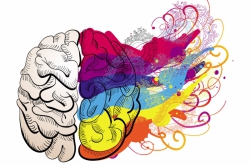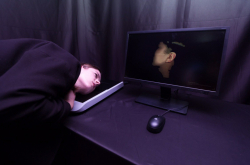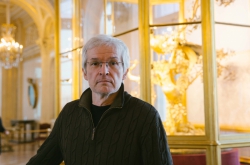Ostin Nevin, Research Associate at the Institute of Photonics and Nanotechnology (Italy): "Environments: cultural heritage preservation and the art of light".
One of the questions that stands before scientists is how did artists create their works? I mean — how were pigments, or art glass, created? No one would allow me to just take an art object and do a chemical analysis — yet, if I did, I would have made a lot of discoveries and helped restoration artists do their work a lot better. So, what does museum staff have to do to prevent art objects from deteriorating?
Art objects are really sensitive to changes in environment, mostly to temperature and humidity. One even has to mind the conditions outside the museums — for instance, if the temperature indoors is 22 degrees plus, and it's minus 20 outdoors, that would be harmful to paintings. The situation is similar for humidity, as well — the museum is a public place, and visitors bring moisture in.
 ITMO University. Ostin Levin
ITMO University. Ostin Levin
In the beginning of the 19th century, many artists painted on wood panels. When humidity levels change, these panels cover with cracks. Sometimes, it is hard to define the condition of such art object; yet, we can use holographic interferometry to track dynamic changes in the painting. Thus, we can see what happens to paintings during different changes in the environment. This shows us the importance of maintaining certain conditions.
Surely, that's not only about temperature and humidity. Chemical compounds in pigments can react with different agents in the air. Sometimes, the color of a pigment depends on molecule configuration. Smalt, for instance, is bright blue. Yet, if cobalt configuration changes, it turns black. Sometimes, we have to use special methods to find out which color a particular part of the painting was. Using spectroscopy, we can track the chemical composition of pigments and their "chemical history", and find out their initial colors.
Also, unanticipated reactions can happen as results of the effects of light, or with some particles brought from outside. For example, in 1920-s scientists discovered several paintings in Egypt — those were in ideal condition, as they were stored in enclosed space for several thousand years. Yet, in a couple of years they covered with salt. This happened because the paintings were exhibited, so they started reacting with sand from the desert which contains different salts.
 "Last Supper" mural. Credit: milanodavai.com
"Last Supper" mural. Credit: milanodavai.com
The effects of environment can make it hard to define the genuineness of a painting. For example, Da Vinci's "Last Supper" is severely damaged. To understand how it was painted, we can use a microscope and track the process. We know that Leonardo did not mix the paints, but painted in layers: he created different colors by putting pigments atop each other.
Restoration artists and museum staff have to account for such things so that art objects won't deteriorate faster. Surely, even science can't give us precise information on how a painting initially looked like. Yet, we can understand which color was used for each element of the painting. From a historian's point of view, we also study the conditions people lived in and the tools they used.
Vadim Fishkin, artist and professor at the Karlsruhe Institute of Technology (Russia/Slovenia): "Light" Matters: all around the world
In many of my works, I've asked myself: who is an artist? What is he? When thinking about this subject, I got the idea of using pulsations of light to picture my heartbeat. But how can one do it? I started to study the problem of transmitting heartbeat over distance. That was in 1996, when mobile phones were not yet common, and one had to pay for every minute of using the Internet. I found a programmer who offered to transfer information about by heartbeat to Rotterdam, where the lamp was located, every 20 minutes. I wanted to make the pulsations and my heartbeat synchronous, but I had no choice then. In the end, I had to carry a radio transmitter around. Later, in 2011, when I decided to repeat the project, I had a special program on Android written for me. Many people thought of this project as a work about technology; as for me, that was just a way of simply saying "I am alive".
 ITMO University. Vadim Fishkin.
ITMO University. Vadim Fishkin.
Another example of art based on science is getting images on live green leaves using photosynthesis. I wanted to make reproductions this way. After conducting a range of experiments, I understood that the plants have to be very sensitive to light. I wanted to make a major exhibition, but, unfortunately, not all of my experiments were successful, so I only created several pieces, including my self-portrait.
I had another project in the field of Art&Science dedicated to Alexander Chijevsky, a soviet biophysicist, philosopher and poet. He studied the sun's effect on different biological processes, as well as social and historical events. My idea was to create an "eternal sunset". I've asked 40 organizations worldwide to fix web-cams facing the sunset. A program switched from one camera to another as soon as the sun reached the horizon. In every part of the world, there were a couple of additional cameras, so that I could always have a view of a clear sky.
 ITMO University. Art&Science project at the State Hermitage
ITMO University. Art&Science project at the State Hermitage
One more project was on a question I've always wondered about since childhood: what is located precisely on the other side of the planet? At first, the solution seemed to be simple: I was to calculate the exact geographical locations, contact the people there and ask to make photographs. I wanted to use different museums as initial points, so that to exhibit the photographs there. Yet, it turned out that in most cases, the other side was all water. What would be the point of exhibiting such photos? So I thought up a different idea: to use the images of the ocean floor. Naturally, this led to another problem: where to get them? In the end, I contacted a specialist from the National Institute of Water and Lithosphere in New Zealand, who said that was his field. He sent me the images and all the other necessary information. Next time, the location I needed was in Argentina — and yet again, I got help from a person I didn't even know, some dentist who spent his vacation nearby. It's just great how people are eager to help artists!





